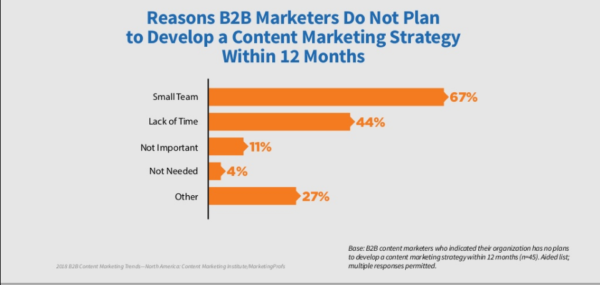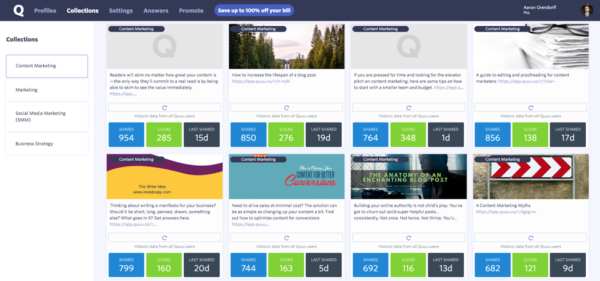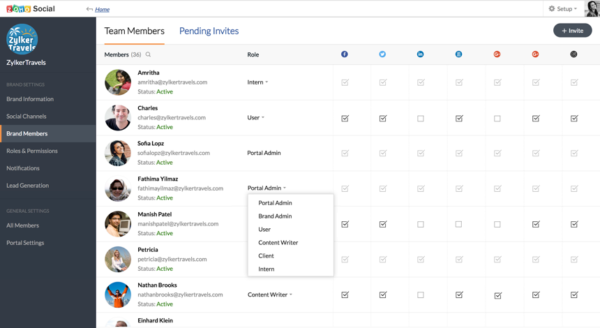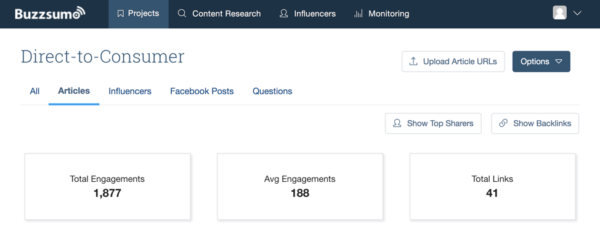 Editor’s note: You may have missed the original version of this post a couple years ago. We’re sharing Aaron’s updated version today, as more efficient teamwork is a constant need for content marketers.
Editor’s note: You may have missed the original version of this post a couple years ago. We’re sharing Aaron’s updated version today, as more efficient teamwork is a constant need for content marketers.
As content marketers, we have our work cut out for us.
Getting original ideas off the ground is hard enough. Unfortunately, when we add all the curating, collecting, and collaborating necessary for full-scale engagement, overwhelmed is an understatement.
Yet, curating and collaborating is essential. And not just for in-house research. By a landslide, social media posts top the lists of types of content both B2C (96%) and B2B (94%) marketers say they use.
The problem is that social media marketing is notoriously self-centered. Without curation, we inevitably pack our feeds with pitch after promotion after pitch. And, without collaboration, we end up being echo chambers of our proclivities — instead of a diverse repository of thought leadership.
Without curation, marketers pack their feeds with pitch after promotion after pitch, says @AaronOrendorff.
Click To Tweet
When Content Marketing Institute and MarketingProfs asked B2B marketers what was holding them back from developing a full-scale content marketing strategy, the top two roadblocks were a “small team” (67%) and “lack of time” (44%):

The question is: How can you create a system to curate and collaborate on content that doesn’t require more people or waste your time?
The answer lies in these 11 tools.
HANDPICKED RELATED CONTENT:
1. Quuu
Before getting into Quuu, let me head off an objection: “How is Evernote not No. 1?”
Two reasons. First, because most of us already use Evernote for content marketing, including it wouldn’t be groundbreaking. Second, mastering Evernote can be daunting and it’s not a platform I can speak to with expertise.
What I can speak to is the desire to automate social sharing without losing the human touch.
Use @quuu_co to automate social sharing without losing the human touch, says @AaronOrendorff.
Click To Tweet
Enter Quuu. Quuu is the first social-sharing automation tool curated by humans, vetted by humans, designed for humans. Here’s how it works:
The Quuu community submits unique social posts through Quuu Promote into categories that are reviewed by Quuu’s editorial board to ensure quality. Those posts are then shared automatically across your connected social accounts — Twitter, LinkedIn, and Facebook — or you can have Quuu send you daily suggestions to quickly sort through yourself. Both the automatic sharing and suggestions are based on your selection of relevant categories.
In addition, its Collections offer even more choices for direct and native sharing:
But, what if you want to go beyond individual curation?
2. Smarp
Naturally, I’m a huge fan of Slack for direct sharing and company-wide communication channels. The struggle with Slack is that — without augmentation from plug-ins — it’s difficult to overlap with group collecting and direct social sharing.
With a UI that resembles social networks, Smarp specializes in employee advocacy: the art of leveraging staff at all levels to become brand ambassadors.
Use @BeSmarp to solicit #content for sharing or research within departments. @AaronOrendorff
Click To Tweet
While that external focus is valuable, you can also set up Smarp for internal collaboration around categories or departments. By essentially creating “feeds,” marketers can more easily collaborate with subject matter experts within their companies to (1) solicit content for sharing or research, (2) start niche dialogues around that content, and (3) enable integrated social sharing either from official channels or by employees themselves.
3. Zoho Social
As a collection-and-sharing hub, Smarp excels. But what if you need more granular control over internal roles as well as external clients? That’s where Zoho Social comes in. Zoho is a full-scale social-sharing platform akin to Buffer or CoSchedule on agency-enabling steroids.
For the purposes of this article, it’s the collaboration tool set that shines.
A collaboration tool like @zohosocial allows you & your team to make decisions faster. @AaronOrendorff
Click To Tweet
On Zoho, for instance, you can set roles with corresponding access and permissions. Clients can view and interact with shared dashboards, collaboration tabs, and reports, while staff — e.g., writers or social media managers — can alternate between open and closed conversations.
4. Flipboard
Where the previous two tools excel as closed hubs for content curation and collection, Flipboard operates at the other end of the spectrum. With just over 100 million monthly active users in nearly 200 countries, its audience falls evenly along generational lines — millennial, generation X, and baby boomer — as well as gender lines.
Built to be the content equivalent of Pinterest’s visual dominance, Flipboard is a robust platform not just for public-facing curation but for driving traffic.
.@Flipboard is a robust platform for public-facing curation AND for driving traffic, says @AaronOrendorff.
Click To Tweet
Although it lacks the seamless social integrations and control levels of Zoho, you can still use Flipboard to create private boards for internal collaboration with your team:
5. Curata
Pawan Deshpande, CEO and visionary behind Curata, knows a thing or two about content.
He has worked for both Microsoft and Google, so when he talks about content curation, we listen:
By having content curation involved in your company’s overall marketing plan, your company can save time, money, and resources. Without it, your company’s content marketers will be suffering from burnout. Content curation is the only way to go.
Without #content curation, your company’s content marketers will be suffering from burnout. @TweetsFromPawan
Click To Tweet
Curata’s content curation software — a paid service — guides you through the process of finding, curating, and sharing content to your target market with consistency and data-backed ease.
Curata’s specialty is personalization. Discover and sort content served up from a smart engine. It’s this intelligent content technology that allows Curata to learn your interests and directly deliver content that’s valuable to you.
6. ScribbleLive Trapit
Following in Curata’s footsteps, ScribbleLive Trapit is another reader-learning engine.
However, ScribbleLive’s specialty is tapping into the content curation and publishing power that most enterprise organizations overlook — their employees. By enlisting insiders for ideas and promoting content from the inside out, you can improve your organic following, influence, and overall reach.
.@scribblelive is a tool that learns interests of users & gathers custom-picked articles. @AaronOrendorff
Click To Tweet
This discovery tool, which has been compared to Flipboard, learns the unique interests of each user and gathers custom-picked articles.
Boost your content marketing ROI by empowering people across departments to become advocates, evangelists, and leaders among their online circles.
7. BuzzSumo
BuzzSumo is the mother of all social-measuring and virality tools. Back when I was targeting mainstream publishers for guest posting, it was literally my first stop in the research process.
Why? Because BuzzSumo allows you to search URLs (i.e., domains) or keywords using a host of filters — like date, location, content type, and even word count — and then share that content directly to every imaginable platform:
Of course, you probably know that already. What you might not know — and the reason BuzzSumo is one of my go-to tools for collection and curation — is you can create team “Projects” by saving specific results or uploading a bulk list of URLs:
Projects let you not only collaborate internally, they also enable you to identify the top influencers in very specific niches to reach out for external collaboration. Plus, the Chrome extension works almost identically to Evernote with all the added benefits mentioned above included.
Use @buzzsumo to identify top influencers to reach out to for external collaboration. @AaronOrendorff #tools
Click To Tweet
8. Scoop.it!
If you’re unfamiliar, Scoop.it! grew up as a lowly algorithm destined to change the way content is promoted, shared, and curated. Since its 2011 launch, Scoop.it! has built a thriving community appealing to individuals and businesses alike.
When you’re on Scoop.it!, you’re essentially surfing the web to find vetted and targeted content from and for your audience. You can then “scoop it” to publish either your own work or your favorite pieces from other sites.
Instant, one-click publishing is what makes Scoop.it! especially valuable for content curation management. Not only does this create a digital paper trail to mine, but it also connects you with influencers in your niche.
Instant, one-click publishing is what makes @ScoopIt valuable for #contentcuration management. @AaronOrendorff.
Click To Tweet
Options for discovering, publishing, and curating content abound.
9. Feedly
Here’s a Really Simple Syndication (RSS) feed that truly satisfies when it comes to content curation. We all know that reading is good for idea formation, but not every feed reader is created equal.
Feedly delivers by offering a business-centered content focus. Also, it incorporates YouTube videos to add a powerful boost to the written content world.
Feedly’s best benefit is its privacy feature. You can conduct your content brainstorming behind the scenes with your team. This is a huge bonus, as content creation success hinges on the ability of your team to work together. In fact, teamwork is the focus of the next tool on the list as well.
.@feedly’s best benefit is its privacy feature, says @AaronOrendorff. #contentcuration #tools
Click To Tweet
10. Triberr
If it takes a village to raise a child, what does it take to raise a company’s content?
Triberr. One of the non-obvious ways to promote content is to dive into a content community. Triberr is essentially a digital coffeehouse or corner pub, delivering readers to your content while exposing you to new content. Blogger communities can support each other’s content, inspire ideas, and drive traffic from one location.
While criticized for its auto-posting tactics (theoretically, a user can tweet about an article without ever reading it), Triberr remains a premier method of exchanging ideas and accolades in a professionally focused group.
Use @Triberr to exchange ideas & accolades in a professionally focused group. @AaronOrendorff #tools
Click To Tweet
11. Pinterest
To be honest, I never would have thought to include Pinterest as a content curation tool. Sure, it’s a great marketing and community platform, but collection and curation?
What opened my eyes was Nicole Kohler’s article, The Powerful Content Curation Tool You’re Not Using:
Pinterest may seem like just another fluffy, feel-good website full of cupcake photos and endless boards of shoes, but beneath its soft exterior lies the makings of a powerful content curation machine.
What makes Pinterest a powerful content curation machine? First, Pinterest is a direct connection to your audience. Follow your followers and your feed will hand you what they like.
Second, Pinterest is visual. As you build a content library it can be easy to become fixated on SEO, keywords, and search queries. Pinterest reminds us that humans are creatures heavily reliant upon visual cues.
Follow your @Pinterest followers & your feed will hand you the #content that they like. @AaronOrendorff
Click To Tweet
Another great feature of Pinterest is that it can boost creativity when it comes to your content ideas. And — since the half-life of Pinterest content is three and a half months — your team won’t be finding stale material.
More curating, less time
Naturally, diving into all 11 tools for curating, collecting, and collaborating can be overwhelming. So don’t. The point is to simplify your process and find out what works for your content curation management needs.
Please note: All tools included in our blog posts are suggested by authors, not the CMI editorial team. No one post can provide all relevant tools in the space. Feel free to include additional tools in the comments (from your company or ones that you have used).
Curate hundreds of great content marketing lessons in a single location. Register today for Content Marketing World Sept. 4-7 and use code BLOG100 to save $100.
Cover image by Joseph Kalinowski/Content Marketing World
The post 11 Content Curation and Collaboration Tools to Save You Time appeared first on Content Marketing Institute.
from Content Marketing Institute https://ift.tt/2Km8VI5














No comments:
Post a Comment